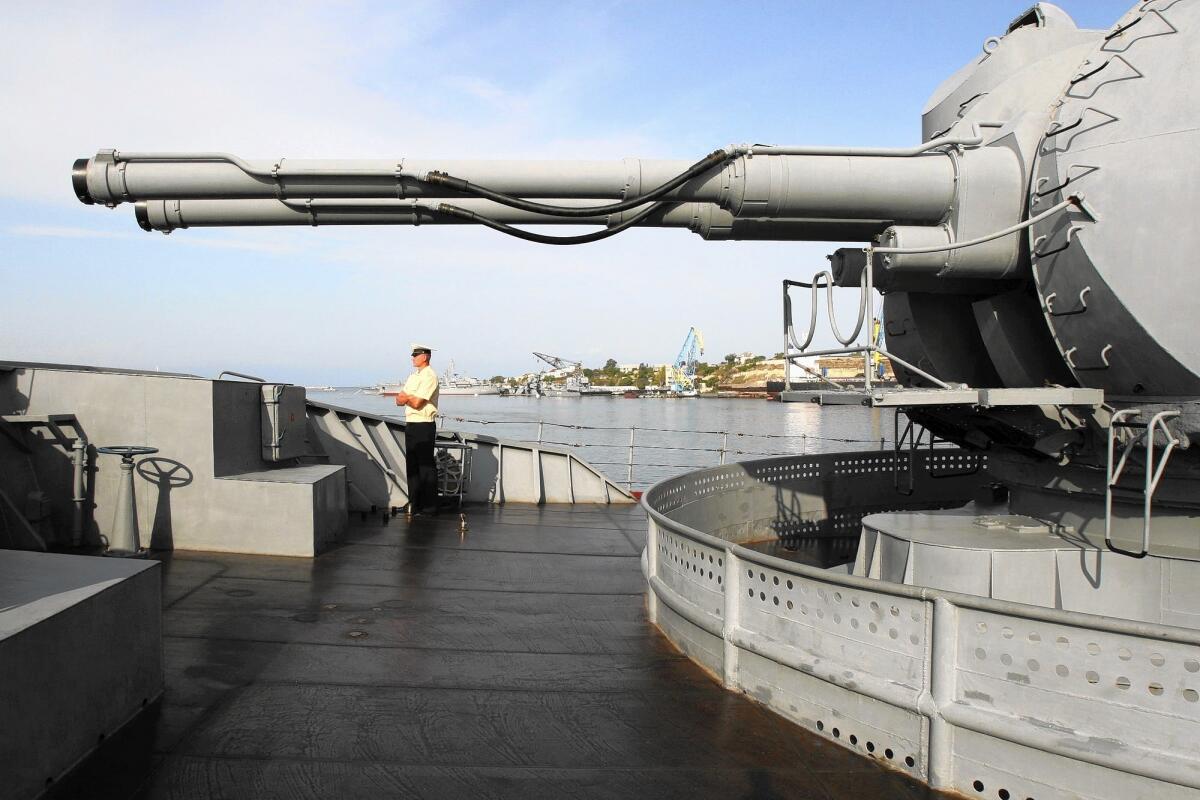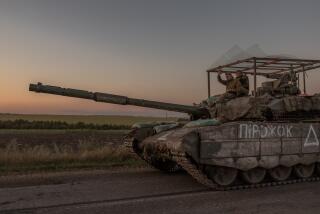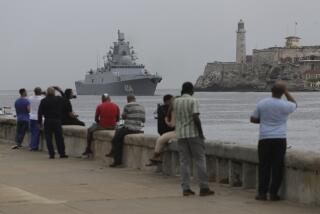Russiaâs grand plan to modernize navy is tripped up by economy

reporting from MOSCOW â Itâs been 15 years since a torpedo exploded aboard the Kursk, sinking the Russian submarine, killing all 118 sailors aboard and wounding the navyâs reputation and the nationâs pride.
A tragic metaphor for government neglect of once-powerful armed forces, the disaster spurred ambitious plans for military expansion and modernization in the air and on the ground and high seas, which came to fruition a decade later when high oil and gas prices filled Moscowâs coffers.
But the Russian navyâs generous share of Project 2020 military modernization funds â $156 billion for the shipbuilding and base-construction plans were designated in 2010 â is imperiled by a financial crisis brought on by Western sanctions and lower petroleum prices.
Although President Vladimir Putin has said that Russia remains on course to restore the reach and firepower of the fleet launched by Peter the Great in 1696, veteran military analysts and Kremlin insiders point out that the recession has cut the rubleâs buying power in half and the protracted decline in petroleum prices makes it unlikely that Russia can afford the 50-plus warships that were intended for commissioning this decade.
Bolstering naval forces is a crucial part of the Kremlinâs âbasic goal of strengthening the countryâs positions among the worldâs leading sea powers,â Mikhail Popov, deputy chief of the Russian Security Council, said in August, after Putin signed a new Maritime Doctrine that assumes a reinvigorated Russian fleet.
Revisions to the 2010 defense mission statement were few when the security chiefs rewrote it last year to incorporate the Kremlinâs muscular assertions of power in a claimed âsphere of influenceâ in former Soviet territories. The new doctrine identifies NATO as the main threat to Russian security and claims the right to use nuclear weapons to defend against any aggression seen as imperiling an independent Russia.
Expanding the size and sophistication of the nationâs ramshackle naval fleet is essential to Moscowâs strategic priorities: Russiaâs move in late September to join the international air campaign against Islamic State militants in Syria highlighted its need for sea-based platforms from which to launch airstrikes and surveillance. An unspecified number of large, ballistic missile-armed amphibious assault ships and a nuclear-powered aircraft carrier capable of carrying a dozen aircraft and 450 marines are envisioned in the modernization plan, navy commander Adm. Viktor Chirkov told reporters at a St. Petersburg naval show in July.
Nine new or revitalized Soviet-era nuclear submarines are included in the modernization timetable. Three are intended to enhance patrolling of disputed island and natural resource claims in the Pacific. The other six are destined for the Northern Fleet, where Russia seeks to control a new shipping passage opening north of its landmass as Arctic ice melts.
Two new icebreakers to assist with navigation through the Arctic have also been authorized, and the production plans for frigates, destroyers and other surface warfare ships were expected to expand the fleet by 50 vessels by decadeâs end. That would exceed the number of Russian naval vessels built and launched in the entire 24 years since the Soviet Union collapsed.
âIt is a reflection of Russiaâs need to be seen as a great power,â said Alexei Arbatov, a strategic analyst at the Carnegie Moscow Center. But he noted that the ambitious construction plans have been complicated by the deepening economic crisis.
In punishment for Russiaâs seizure of Ukraineâs Crimea region in March 2014 and its not-so-secret support of pro-Russia separatists in the neighboring countryâs eastern regions, the United States and the European Union imposed sanctions. Arms and military-industrial trade have been banned, senior officials and businessmen have been blacklisted and Russian access to international lending institutions has been terminated. France, where defense contractors had just completed the first of two Mistral warships on contract with the Kremlin last year, canceled delivery and refunded Moscowâs $2.35-billion purchase price and related investments.
Those constraints on Moscowâs ability to marshal foreign financing and components have compounded the blows dealt the Russian economy by oil prices that have fallen by half in the last 18 months. Russia depends on oil and natural gas sales for at least 50% of its annual budget, and the slumping commodities revenue has imposed social services cuts and fanned inflation.
Russiaâs fleet comprises about 270 vessels, but many are Soviet-era and have been ill-maintained, Arbatov said. Only about 45% are combat-ready, he said, underscoring the cost of decades of underinvestment in the navy and the living conditions of its personnel.
He described the Kursk disaster as an enduring âscar on the morale of the navy; not because of a deficiency in the submarine but because of the failure of the Russian command to rescue its sailors. Most people think that the crew could have been rescued but for prestige reasons [the naval command] wouldnât ask for Western assistance.â
In spite of the official Kremlin posture that the projected 2020 fleet strength is on track, âshipbuilding will be seriously curtailed,â Arbatov predicted.
Igor Korotchenko, National Defense magazine analyst and a former officer of the General Staff â Russiaâs rough equivalent of the Joint Chiefs â acknowledges that the delivery of new ships is likely to be delayed unless the economy makes an unexpectedly speedy recovery.
âConstructing fleet is time-consuming and very expensive,â he said, pointing to vessels that can involve technology and components from as many as 650 enterprises.
Some veteran defense analysts argue that the modernization project was going to bankrupt Moscow even without the oil price plunge and sanctions.
Russiaâs military brass and intelligence chiefs have convinced Putin that major spending on defense upgrades is necessary for security and to protect strategic interests, said Pavel Felgenhauer, defense analyst for the independent Novaya Gazeta newspaper.
âAnyone who tries to oppose them fails,â he said of the few in Putinâs inner circle who have criticized the General Staffâs demands for more hardware. Most notable among the purged critics was former Finance Minister Alexei Kudrin, sacked in September 2011 after he warned that even a flourishing Russia couldnât afford Project 2020âs cost, then the equivalent of $600 billion.
Felgenhauer pointed out that the new warships will require deep investment in shipyards, home ports and support stations, not all of which are included in the modernization budget. He estimated that at least 40 new bases would be needed in the Arctic, where the shipping passage and newly accessible seabed oil and gas fields will generate more maritime traffic, search-and-rescue operations and icebreaking.
ALSO
Attack in France spotlights Europeâs vulnerability to terrorism
After Paris attacks, the Lebanese ask where their Facebook safety feature went
France launches new airstrikes amid reports that Paris attacks were directed in Syria
More to Read
Sign up for Essential California
The most important California stories and recommendations in your inbox every morning.
You may occasionally receive promotional content from the Los Angeles Times.











